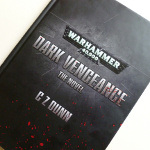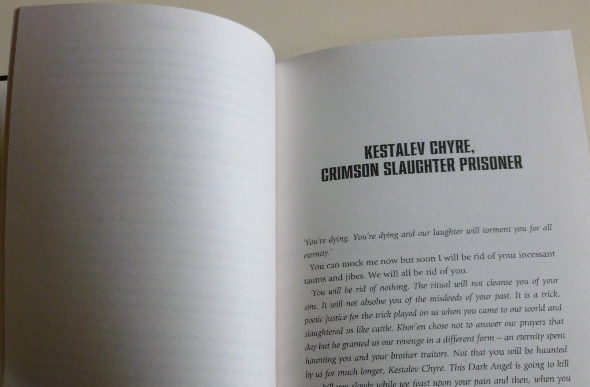 I got my hands on the Dark Vengeance novel, the £12.00 story by C. Z. Dunn GW released along with the 40K starter box of the same name. Above all, I wanted to see GW ‘s spin on the Crimson Slaughter, the newly introduced Chaos Marine Renegades. As most 40K-fiction on Chaos Marines centers on the Traitor Legions (and occasionally the Red Corsairs), I was curious to see their take on a fresh Renegade faction.
I got my hands on the Dark Vengeance novel, the £12.00 story by C. Z. Dunn GW released along with the 40K starter box of the same name. Above all, I wanted to see GW ‘s spin on the Crimson Slaughter, the newly introduced Chaos Marine Renegades. As most 40K-fiction on Chaos Marines centers on the Traitor Legions (and occasionally the Red Corsairs), I was curious to see their take on a fresh Renegade faction.
To put my verdict up front: It was a very strange book to read indeed.
A Dilemma of Perspectives and Reader Information
I will start with things I did not like about the book; or that I thought did not work very well.
- First, the book is written entirely in first-person perspective from the point of view of different characters. This is somewhat reminiscent of characters-perspectives used in the excellent A Song of Ice and Fire Series by George R. R. Martin, which I think will be known to many (if you don’t know these books, you should give them a try).
- Second, it uses a lot of characters. There are at least 10 to 15 different characters heading a chapter. Many appear only once and despite viewing the action “through the eyes” of them in first-person, the all seem much the same.
- Third, and part of the reason for No. 2, is that there is a lot of description, basic 40K introduction and characterization going on. The various “first-person-narrators” either introduce themselves or describe what is going on around them to the reader.
Compressed into the short text of a barely 100 page story (see below), this gives the book a very odd tone. On one hand, Dunn transports the reader right “into the mind” of the different characters. But as you read them, they all seem very much alike.
There is very little difference in style or tone, whether you are reading the view of a circumspect Dark Angels Sergeant or watch events unfold through the eyes of a raging Helbrute. The reason for this, I believe, is that at all times, the characters need to tell the reader a lot about their background and the unfolding events around them.
Here is an excerpt that is exemplary of what to expect in the book. Those are the first lines introducing the Cultist Anarkus to the reader. He only appears once in the book.
I have waited my entire life for this moment.
The skeins of fate have drawn tight around this precise point in time, my entire existence channelled towards this instant. From the difficult labour that killed my mother, through the rampant alcoholism that claimed my father, and beyond the gates of the Ecclesiarchy orphanage on Gethsemane VII where I was cared for until I was old enough to work in the gas mines, the tides of fortune have carried me inexorably towards my destiny.
Today is the day I am going to slay a Space Marine.
Lines like these just don’t work for me in first-person. They sound like character-notes on the different persons and might have slipped by in a third-person narration. But in this book, it always struck me as odd when characters dive off into prolonged internal thoughts that detail their personal history, often right in the middle of a firefight.
The other odd thing was that all the characters sounded too much alike. The DA Librarian was the only character whose PoV stood out as being different, simply because his psychic glimpses of future events gave his chapters a different and unique quality.
In short, I believe a more “traditional” third-person perspective would have been more suited to this story.
A Very Expensive Short-Story: Why Not a Leaflet in the Box?
Moreover, the Dark Vengeance novel is very short. I certainly did not expect a full-fledged book of the sort you get when you buy a Horus Heresy novel. Nevertheless, this novel (or novella, it is described as both) is barely 126 pages long. More than 25 pages are also left blank ahead of new chapters. Typeface and line space are rather generous as well.

126 pages, and many of them left blank
Given the brevity of the text, I believe the story could have fitted very well into a soft booklet of (with less white space) perhaps 30-odd pages. The latter would have fit right into the Dark Vengeance starter box itself without a problem.
Considering how much effort they take to use all the different characters and types from the box – Tac Marines, Ravenwing, Cultists, Hellbrute – and is (according to C Z Dunn) the adaptation of one of the scenarios in the box, I feel that this was a missed opportunity to imbue the box itself with a bit more background.
In the current format of a separate, limited and rather pricy book, most players will likely give the Dark Vengeance novel a miss. This is a pity, because it is this story that aims to bring the characters and the missions from the Dark Vengeance box to life.
The Fun Comes at the End…
Enough with the criticism. Having said all that, Dark Vengeance is not a bad story at all. The further along I read (getting behind some of the basics, such as the idea behind a Dreadnought or the Dark Angel’s secret), the more I enjoyed it.
As the different elements of the dispersed cast – outriding Ravenwing, Deathwing waiting for a teleport, scouting Tacticals – converge upon the final battle, the first-person PoV is starting to work a bit better and helps build tension.
I didn’t really feel much attachment to any one character. As said, only the Librarian’s chapters really stood out as unique and there are simply too many characters introduced and dropped again in too little time. The showdown however unfolds in a great sequence of near-defeats, cliff-hangers and just-in-time arrivals that keeps the pages turning.
The slow build-up to the introduction of the Helbrute is also suitably scary. The fights are well paced. And the book did certainly not lack in grimdark gore and blood (no, you certainly do not want be questioned by a Dark Angel Interrogator Chaplain!).
Overall, I did enjoy the book and the second half in particular.
The Crimson Slaughter and the threat of Chaos
Part of why I enjoyed it was the Crimson Slaughter. The Dark Angels get the lion’s share (sorry) of the attention, but nothing written here about Dark Angels came close to some of the fantastic stories – example ADB’s Savage Weapons – that are already out there.
I much more enjoyed the (very few) glimpses at the Crimson Slaughter (formally the Chapter of the Crimson Sabres) and how they fell to the Dark Gods. I know the original Traitor Legions are the fan-favorites among Chaos Players, but I really liked how, in this novel, they stressed the constant threat of Chaos to turn and corrupt the stout Space Marine defenders of the Imperium at the slightest lapse of vigilance.
Several times, C Z Dunn has his Dark Angels reflect on how the roles could easily have been reversed.
… thank the Lion that it was not the Dark Angels who had heeded the call that day [...], that it was not our proud brotherhood that was laid low by so base a trick of the arch-enemy.
The Crimson Slaughter, like all Chaos Marines, are arch enemies to the Imperium. Yet the echo of their own loyal and glorious service to the Imperium is never far away. In their own deluded ways, they are also fighting for salvation and one could, as a reader, even sympathise with them.
I hope we will get some more of that in the upcoming Codex: Chaos Space Marines. Space Marines fighting Chaos Marines, who turned 10.000 years ago is one thing. Space Marines fighting more recently fallen Chaos Marines, who could well have been themselves, adds a much more personal and intimate note of horror to 40K’s “grimdark” universe.
In summary, the story was good enough that I would’ve liked if GW made it more readily available as a booklet with the Dark Vengeance book (or perhaps as a pdf once the limited book-run is done), even with its rather odd first-person narration.
However, as short as the story is, I would not recommend it for the price they are asking.








